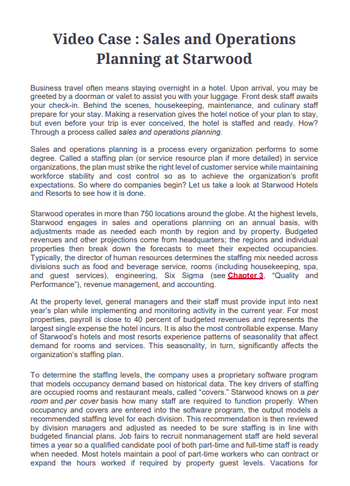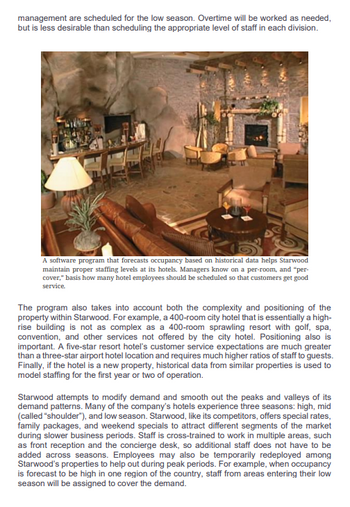
Practical Management Science
6th Edition
ISBN: 9781337406659
Author: WINSTON, Wayne L.
Publisher: Cengage,
expand_more
expand_more
format_list_bulleted
Question
Please help to answer below with refer to attached.
How would staffing for the opening of a new hotel or resort differ from that
of an existing property? What data might Starwood rely upon to make sure
the new property is not over- or understaffed in its first year of operation?

Transcribed Image Text:Video Case: Sales and Operations
Planning at Starwood
Business travel often means staying overnight in a hotel. Upon arrival, you may be
greeted by a doorman or valet to assist you with your luggage. Front desk staff awaits
your check-in. Behind the scenes, housekeeping, maintenance, and culinary staff
prepare for your stay. Making a reservation gives the hotel notice of your plan to stay,
but even before your trip is ever conceived, the hotel is staffed and ready. How?
Through a process called sales and operations planning.
Sales and operations planning is a process every organization performs to some
degree. Called a staffing plan (or service resource plan if more detailed) in service
organizations, the plan must strike the right level of customer service while maintaining
workforce stability and cost control so as to achieve the organization's profit
expectations. So where do companies begin? Let us take a look at Starwood Hotels
and Resorts to see how it is done.
Starwood operates in more than 750 locations around the globe. At the highest levels,
Starwood engages in sales and operations planning on an annual basis, with
adjustments made as needed each month by region and by property. Budgeted
revenues and other projections come from headquarters; the regions and individual
properties then break down the forecasts to meet their expected occupancies.
Typically, the director of human resources determines the staffing mix needed across
divisions such as food and beverage service, rooms (including housekeeping, spa,
and guest services), engineering, Six Sigma (see Chapter 3, "Quality and
Performance"), revenue management, and accounting.
At the property level, general managers and their staff must provide input into next
year's plan while implementing and monitoring activity in the current year. For most
properties, payroll is close to 40 percent of budgeted revenues and represents the
largest single expense the hotel incurs. It is also the most controllable expense. Many
of Starwood's hotels and most resorts experience patterns of seasonality that affect
demand for rooms and services. This seasonality, in turn, significantly affects the
organization's staffing plan.
To determine the staffing levels, the company uses a proprietary software program
that models occupancy demand based on historical data. The key drivers of staffing
are occupied rooms and restaurant meals, called "covers." Starwood knows on a per
room and per cover basis how many staff are required to function properly. When
occupancy and covers are entered into the software program, the output models a
recommended staffing level for each division. This recommendation is then reviewed
by division managers and adjusted as needed to be sure staffing is in line with
budgeted financial plans. Job fairs to recruit nonmanagement staff are held several
times a year so a qualified candidate pool of both part-time and full-time staff is ready
when needed. Most hotels maintain a pool of part-time workers who can contract or
expand the hours worked if required by property guest levels. Vacations for

Transcribed Image Text:management are scheduled for the low season. Overtime will be worked as needed,
but is less desirable than scheduling the appropriate level of staff in each division.
A software program that forecasts occupancy based on historical data helps Starwood
maintain proper staffing levels at its hotels. Managers know on a per-room, and "per-
cover," basis how many hotel employees should be scheduled so that customers get good
service.
The program also takes into account both the complexity and positioning of the
property within Starwood. For example, a 400-room city hotel that is essentially a high-
rise building is not as complex as a 400-room sprawling resort with golf, spa,
convention, and other services not offered by the city hotel. Positioning also is
important. A five-star resort hotel's customer service expectations are much greater
than a three-star airport hotel location and requires much higher ratios of staff to guests.
Finally, if the hotel is a new property, historical data from similar properties is used to
model staffing for the first year or two of operation.
Starwood attempts to modify demand and smooth out the peaks and valleys of its
demand patterns. Many of the company's hotels experience three seasons: high, mid
(called "shoulder"), and low season. Starwood, like its competitors, offers special rates,
family packages, and weekend specials to attract different segments of the market
during slower business periods. Staff is cross-trained to work in multiple areas, such
as front reception and the concierge desk, so additional staff does not have to be
added across seasons. Employees may also be temporarily redeployed among
Starwood's properties to help out during peak periods. For example, when occupancy
is forecast to be high in one region of the country, staff from areas entering their low
season will be assigned to cover the demand.
SAVE
AI-Generated Solution
info
AI-generated content may present inaccurate or offensive content that does not represent bartleby’s views.
Unlock instant AI solutions
Tap the button
to generate a solution
to generate a solution
Click the button to generate
a solution
a solution
Knowledge Booster
Similar questions
- Based on this analysis what actions would you recommend to address the issues. Based on the data provided, there are several potential issues at these facilities that could be contributing to the increase in turnover. Here are some of the conclusions that can be drawn: The position Customer Service seems to have some issue with the job itself or with the management of the customer service department as most of the turnover has happened in that position itself. Management is the most common reason cited for leaving, which suggests that employees may not feel that the management is treating them fairly or there may be issues with the management style or with specific managers. Personal reasons are cited in 4 cases, which suggests that there may be issues with work-life balance or with the company culture.arrow_forwardI need help with this questionarrow_forwardAnswer the question in number format 1. What problems presently exist for any person assigned to the position of nursing supervisor? How will these problems impact the selection of the new supervisor? 2. Who should be hired as the supervisor? Why? 3. Who should be hired as the head nurses? Why? 4. Your final decision might not please the staff, and if not, how would you handle the possible uprising?arrow_forward
- University of Phoenix Material The Role of a Health Care Manager Health care management is a growing profession. These managers are expected to manage inpatient and outpatient care facilities as well as non-direct care settings. Therefore, it is important for health care managers to understand the complexity of its roles and functions to build the necessary skills to help them be successful. Complete the following table in which you identify and discuss the role of the health care manager in the following functions: organizing, planning, controlling and leading. In the spaces provided, ensure you identify and discuss them according to these guidelines: Define each of the functions listed. You must define the function in your own words; do not copy the definition from a textbook. Identify and discuss the role of a health care manager in the given function. Provide an explanation that illustrates the role of a health care manager as it applies to the function in the health care…arrow_forwardRead the passage and please answer the questions related to resource planning systems: Whipple Logistics Company’s Transportation Challenge Ruby Shelton is part of the executive development training program. As part of her executive development plan, Ruby has temporarily been assigned to the transportation division of Whipple Logistics Company. The objective is to expose her to different parts of the company as a method of grooming her for a senior position someday. Ruby is excited about the opportunity. Her background is in operations management, therefore, she is familiar with transportation requirements, although not an expert. Doreen Delgado is Ruby’s mentor in the program. Doreen is a senior vice president and participated in the program when she was a junior executive. She understands the value of such a learning experience. Whipple Logistics Company has several new clients who want a briefing on the best mode of transportation for their businesses. Doreen assigned Ruby to this…arrow_forwardPrim's MST approach may be utilized build a real-world weighted network.arrow_forward
- Discuss the process of capacity planning in IT resource acquisition and its importance.arrow_forwardEpsilon Airlines services predominantly the eastern and southeastern United States. The vast majority of Epsilon's customers make reservations through Epsilon's website, but a small percentage of customers make reservations via phones. Epsilon employs call center personnel to handle these reservations and to deal with website reservation system problems and for the rebooking of flights for customers whose plans have changed or whose travel is disrupted. Staffing the call center appropriately is a challenge for Epsilon's management team. Having too many employees on hand is a waste of money, but having too few results in very poor customer service and the potential loss of customers. Epsilon analysts have estimated the minimum number of call center employees needed by day of the week for the upcoming vacation season (June, July, and the first two weeks of August). These estimates are as follows: Day Monday Tuesday Wednesday Thursday Friday Saturday Sunday Minimum Number of Employees…arrow_forwardChris has been with Drake Manufacturing for five years and was recently promoted to the position of shift supervisor. He is still learning his new position, and it is important to him to be liked and respected. At the most recent operations review meeting, the director reported that the company’s financials are troublesome, and managers should be prepared for a major reorganization. Several jobs will be eliminated, but it had not yet determined which departments would be affected. Questions 1.Should he give his employees “small doses” of the impending change?arrow_forward
- In a one-page paper, list the advantages and disadvantages of using part-time employees to help meet demand.arrow_forwardWhat problems presently exist for any person assigned to the position of nursing supervisor? How will these problems impact the selection of the new supervisor? Who should be hired as the supervisor? Why? Who should be hired as the head nurses? Why? Your final decision might not please the staff, and if not, how would you handle the possible uprising?arrow_forwardHow can service orchestration and choreography be used to coordinate services in a workflow?arrow_forward
arrow_back_ios
SEE MORE QUESTIONS
arrow_forward_ios
Recommended textbooks for you
 Practical Management ScienceOperations ManagementISBN:9781337406659Author:WINSTON, Wayne L.Publisher:Cengage,
Practical Management ScienceOperations ManagementISBN:9781337406659Author:WINSTON, Wayne L.Publisher:Cengage, Operations ManagementOperations ManagementISBN:9781259667473Author:William J StevensonPublisher:McGraw-Hill Education
Operations ManagementOperations ManagementISBN:9781259667473Author:William J StevensonPublisher:McGraw-Hill Education Operations and Supply Chain Management (Mcgraw-hi...Operations ManagementISBN:9781259666100Author:F. Robert Jacobs, Richard B ChasePublisher:McGraw-Hill Education
Operations and Supply Chain Management (Mcgraw-hi...Operations ManagementISBN:9781259666100Author:F. Robert Jacobs, Richard B ChasePublisher:McGraw-Hill Education
 Purchasing and Supply Chain ManagementOperations ManagementISBN:9781285869681Author:Robert M. Monczka, Robert B. Handfield, Larry C. Giunipero, James L. PattersonPublisher:Cengage Learning
Purchasing and Supply Chain ManagementOperations ManagementISBN:9781285869681Author:Robert M. Monczka, Robert B. Handfield, Larry C. Giunipero, James L. PattersonPublisher:Cengage Learning Production and Operations Analysis, Seventh Editi...Operations ManagementISBN:9781478623069Author:Steven Nahmias, Tava Lennon OlsenPublisher:Waveland Press, Inc.
Production and Operations Analysis, Seventh Editi...Operations ManagementISBN:9781478623069Author:Steven Nahmias, Tava Lennon OlsenPublisher:Waveland Press, Inc.

Practical Management Science
Operations Management
ISBN:9781337406659
Author:WINSTON, Wayne L.
Publisher:Cengage,

Operations Management
Operations Management
ISBN:9781259667473
Author:William J Stevenson
Publisher:McGraw-Hill Education

Operations and Supply Chain Management (Mcgraw-hi...
Operations Management
ISBN:9781259666100
Author:F. Robert Jacobs, Richard B Chase
Publisher:McGraw-Hill Education


Purchasing and Supply Chain Management
Operations Management
ISBN:9781285869681
Author:Robert M. Monczka, Robert B. Handfield, Larry C. Giunipero, James L. Patterson
Publisher:Cengage Learning

Production and Operations Analysis, Seventh Editi...
Operations Management
ISBN:9781478623069
Author:Steven Nahmias, Tava Lennon Olsen
Publisher:Waveland Press, Inc.